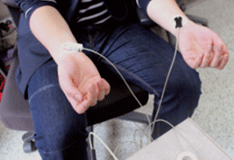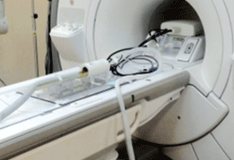The Bio-Med field is divided into two sub-fields: Bioelectronics and Medical Engineering. This field investigates new research challenges for humans and the limits of life through application of sensors, optoelectronics, image processing, and robotics. With the renowned medical school on campus, it is truly an integrated research field with great possibilities in the future.
Bioelectronics
All bio-medical engineering technologies based on electrical and electronic engineering are covered with particular emphasis on element and device levels. Detailed research topics include medical optical imaging and optical sensors, X-ray detectors, nerve signal measurement devices, stem cell spheroids, and implantation devices. The medical optical sensor field develops optical imaging and sensing technologies that help identify, visualize, and quantify bio-molecular processes. To address these applications, the nanophotonics is recognized as an important research topic as well.
Active circuit-level electronics are being developed for local amplification and multiplexed readouts of measured signals. These functions, coupled with the scalability of fabrication schemes, allow hundreds of measurements of millions of potential electrode sites with a single conformal system. These features are especially important when it comes to ECoG or ECG. An ambitious goal is to measure electric potentials on the whole brain surface or heart surface with an oversampled spatial resolution of tens of microns. This mode of operation requires tens of millions of addressed electrodes with local, channel-by-channel signal amplification for each region, enabling high-resolution mapping of electrical activity in large areas of organs.
In addition, bio-implantable electronic devices are being demonstrated. These devices can be absorbed by the body as temporary biomedical implants or disappear harmlessly. There are also future possibilities for new applications such as green electronics or sensitive military hardware.
Medical Engineering

The technology of medical imaging plays a key role in medical diagnosis. Based on this, in-depth research on medical imaging and robotic surgery technologies are conducted. Robots and mechanisms based on animal behavior models, animal neuroecology, animal cognitive systems and biosystems also fall under the research interests. Additionally, chest compression depth measurement devices for CPR are also being developed.
In the field of medical imaging, advanced medical imaging technologies (MRI, CT, X-ray, etc.) such as new contrast mechanisms, fast and accurate image reconstruction, many clinical applications based on computer-assisted diagnostics and engineering techniques are being developed. Electrical feature imaging, metal artifact correction, and viewing angle tilting technologies are good examples, and recently, research using groundbreaking artificial intelligence technology is also being conducted.
There have been efforts to introduce recent artificial intelligence techniques and apply them to medical applications. We are applying deep learning technology to medical image generation, analysis, and diagnosis. We are pioneering the artificial intelligence medical field by learning bio-signals and medical information through artificial intelligence.
As such, our bio-engineering field is a research area in which humans, biology, and engineering interact. This field can be met with the challenge of a lifelong research, and advanced engineering of this field with studies through electrical and electronic engineering methodologies can achieve various human development.
Research labs and advising faculty conducting research in this area are listed below.
| NO | Research Lab | Faculty | Office |
Phone (82-2-2123-) |
|
|---|---|---|---|---|---|
| 1 | Biophotonics Engineering Lab | KIM, Donghyun | C723 | 2777 | kimd@yonsei.ac.kr |
| 2 | Medical Imaging Research Laboratory | Kim, Dong-Hyun | C228 | 5874 | donghyunkim@yonsei.ac.kr |
| 3 | Biological Interfaces and Sensor Systems Laboratory | SEO, Jungmok | C517 | 2868 | jungmok.seo@yonsei.ac.kr |
| 4 | Functional Bio-electronics Lab | Yu, Ki Jun | C224 | 2769 | kijunyu@yonsei.ac.kr |
| 5 | Optical Imaging Systems Laboratory | LEE, Seung Ah | C416 | 2771 | seungahlee@yonsei.ac.kr |
| 6 | Medical Artificial Intelligence Lab | HWANG, DOSIK | C618 | 5771 | dosik.hwang@yonsei.ac.kr |





